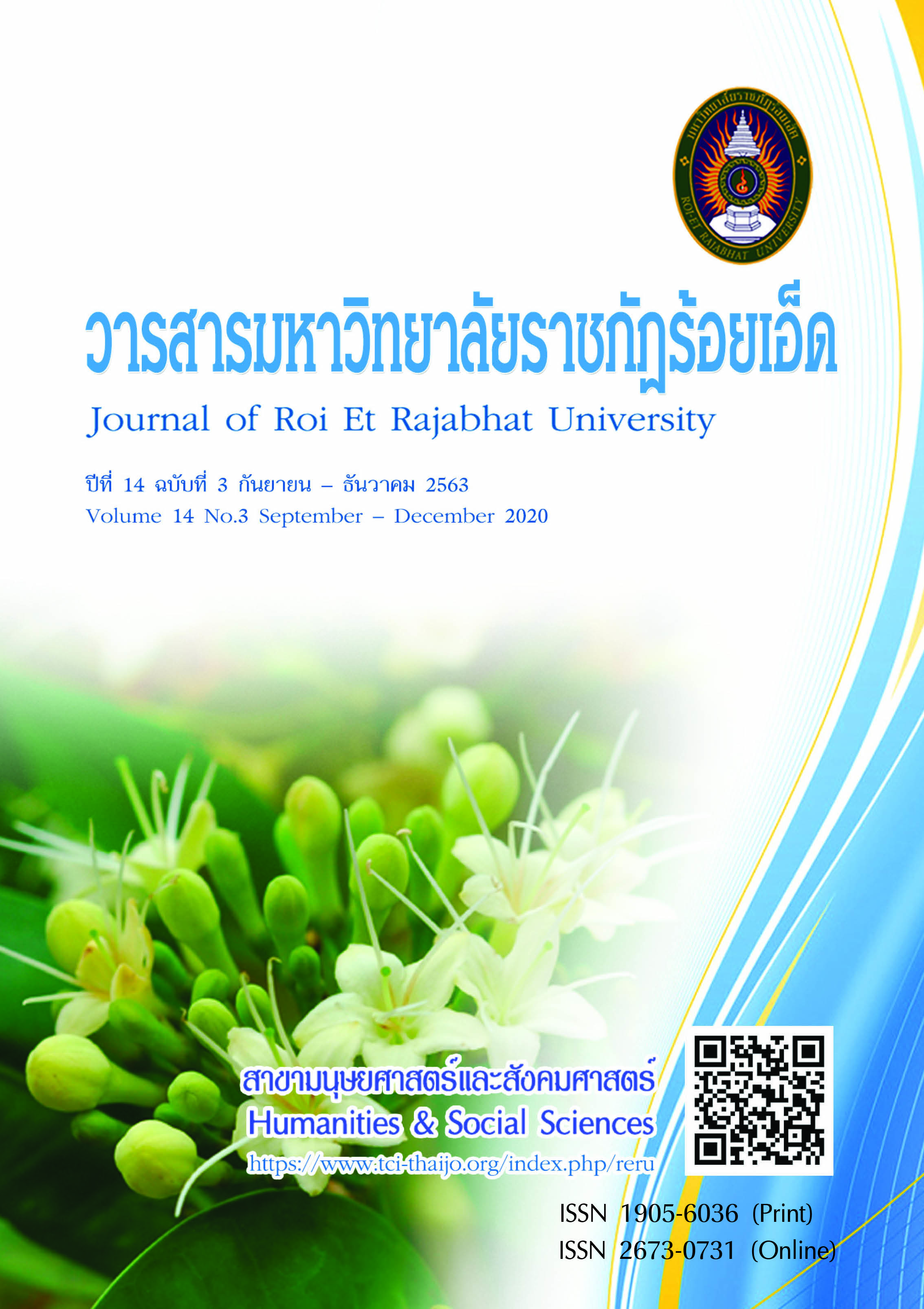Development Guidelines for Cultural Tourism Promotion : A Case Study of Ban Singha Tha Old Town, Mueang District, Yasothon Province
Keywords:
Homestay Potential, Community Participation, Ban Singha Tha Old TownAbstract
The purposes of this study were 1) to examine the local context and potential of the homestays in Ban Singha Tha old town, 2) to observe the local community participation in developing the potential of homestay and 3) to provide guidelines for homestay development in Ban Singha Tha old town in order to promote the cultural tourism of Mueang district, Yasothon province. This study was conducted in the manner of a mixed method research. A questionnaire was used to collect qualitative data with a sample group of 364 Thai tourists who came to visit Ban Singha Tha old town. Moreover, a semi-structured interview form was used for collecting qualitative data with a sample group of 15 participants from government organizations, private sectors, and local people. The statistics used for analyzing the data were percentage, mean, standard deviation and SWOT analysis was employed for analyzing the qualitative data. The result of this research was divided into three aspects: Firstly, context and the potential of the homestays were managed in 10 aspects: 1) accommodation, 2) food and nutrition, 3) safety, 4) friendly hospitality, 5) tour programs, 6) natural resources and environment, 7) culture, 8) creating product value, 9) community management of the homestay group, and 10) public relations. In addition, homestays’ potential in Ban Singha Tha old town was generally rated at a high level. Secondly, the community participated in developing the potential of homestay in four areas: decision making, management, benefits, and evaluation. For guidelines to develop homestays of the Ban Singha Tha old town including the following: the business owners were required to improve and renovate their accommodations with sanitation and safety as well as they should be a friendly and nice host. The touring program should be updated and preserve the culture and environment. It was also necessary to improve the quality and create diversity of local products. These guidelines would allow the community to define their own direction for tourism development in the future.
References
กฤตยา เตยโพธิ์. (2559). วัฒนธรรมโฮมสเตย์ : การพัฒนารูปแบบการจัดการการท่องเที่ยวโดยชุมชน อําเภอวังน้ำเขียว
จังหวัดนครราชสีมา. วิทยานิพนธ์ ศิลปศาสตรมหาบัณฑิต สาขาวิชาการจัดการท่องเที่ยวและโรงแรม.
มหาสารคาม: มหาวิทยาลัยมหาสารคาม.
กระทรวงการท่องเที่ยวและกีฬา. (2557). คู่มือการประเมินมาตรฐานคุณภาพแหล่งท่องเที่ยวทางวัฒนธรรม. กรุงเทพฯ:
โรงพิมพ์องค์การสงเคราะห์ทหารผ่านศึกในพระบรมราชูปถัมภ์.
กระทรวงการท่องเที่ยวและกีฬา. (2557). คู่มือการประเมินมาตรฐานคุณภาพแหล่งท่องเที่ยวทางวัฒนธรรม. กรุงเทพฯ:
สำนักพัฒนาการท่องเที่ยว.
กระทรวงการทองเที่ยวและกีฬา. (2555). มาตรฐานโฮมสเตย์ไทย. สืบค้นเมื่อ 26 กันยายน 2560,
จาก http://www.homestaythai.net/homestay.aspx
การท่องเที่ยวแห่งประเทศไทย. (2560). ย่านเมืองเก่าบ้านสิงห์ท่า. สืบค้นเมื่อ 22 กันยายน 2560,
จาก https://thai.tourismthailand.org/Attraction/
การท่องเที่ยวแห่งประเทศไทย. (2554). แผนพัฒนาและส่งเสริมการท่องเที่ยวของการท่องเที่ยวแห่งประเทศไทย.
สืบค้นเมื่อ 22 กันยายน 2560, จาก http://thai.tourismthailand.org/ tourismthailand_index/th/
การท่องเที่ยวแห่งประเทศไทย. (2552). Home Stay–arm Stay. กรุงเทพฯ: การท่องเที่ยวแห่งประเทศไทย.
ไกรฤกษ์ ปิ่นแก้ว. (2555). การพัฒนานโยบายการท่องเที่ยวเชิงวัฒนธรรมสำหรับจังหวัดพระนครศรีอยุธยาปทุมธานี
และนนทบุรี. รายงานโครงการวิจัย. นนทบุรี: สำนักงานกองทุนสนับสนุนการวิจัย.
ฉันทัช วรรณถนอม. (2552). อุตสาหกรรมการท่องเที่ยว. กรุงเทพฯ: สามลดา.
ชมรมอนุรักษ์มรดกยโสธร. (2559). สถิติข้อมูลนักท่องเที่ยวชาวไทยย่านเมืองเก่าบ้านสิงห์ท่า. ยโสธร: พิมพ์ดีการพิมพ์.
ชมรมอนุรักษ์มรดกยโสธร. (2560). สถิติข้อมูลนักท่องเที่ยวชาวไทยย่านเมืองเก่าบ้านสิงห์ท่า. ยโสธร: พิมพ์ดีการพิมพ์.
ดรรชนี เอมพันธุ์. (2550). การพัฒนาการท่องเที่ยวโดยชุมชนและการจัดกิจกรรมโฮมสเตย์. กรุงเทพฯ: มหาวิทยาลัยเกษตรศาสตร์.
กรมการท่องเที่ยว. (2554). เรื่องกำหนดมาตรฐานบริการท่องเที่ยวมาตรฐานโฮมสเตย์ไทย พ.ศ. 2554. ราชกิจจานุเบกษา
เล่ม 129 ตอนพิเศษ 26ง หน้า 59-63 (31 มกราคม 2555).
รุ่งอรุณ ศุภกฤตอนันต์. (2553). การศึกษาศักยภาพและความพร้อมในการรองรับนักท่องเที่ยวของที่พักแรมแบบโฮมสเตย์ : กรณีศึกษาโฮมสเตย์บ้านลาดสมดี ตำบลกุศกร อำเภอตระการพืชผลจังหวัดอุบลราชธานี. วิทยานิพนธ์ บริหารธุรกิจมหาบัณฑิต สาขาวิชาการจัดการการท่องเที่ยว. ขอนแก่น: มหาวิทยาลัยขอนแก่น.
สุภัคศิษฏ์ ชัยชนะเจริญ. (2559). มาตรฐานโฮมสเตย์ที่ส่งผลต่อการตัดสินใจเลือกที่พักของนักท่องเที่ยวชาว
ไทยในอำเภอเชียงคาน จังหวัดเลย. วิทยานิพนธ์ ศิลปศาสตรมหาบัณฑิต สาขาวิชาการจัดการท่องเที่ยว
และโรงแรม. มหาสารคาม: มหาวิทยาลัยมหาสารคาม.
สำนักงานจังหวัดยโสธร. (2560). ข้อมูลสภาพทั่วไปของจังหวัดยโสธร. สืบค้นเมื่อ 22 กันยายน 2560,
จาก http://www.yasothon.go.th/web/file/menu1.html
สำนักงานปลัดกระทรวงการท่องเที่ยวและกีฬา. (2560). ยุทธศาสตร์สำนักงานปลัดกระทรวงการท่องเที่ยวและกีฬา ฉบับที่ 4
พ.ศ. 2560–2564. กรุงเทพฯ: สำนักงานปลัดกระทรวงการท่องเที่ยวและกีฬา.
สำนักงานพัฒนาการท่องเที่ยว. (2551). รายงานสรุปสถานการณ์โรงแรมและการท่องเที่ยวภายในประเทศ. กรุงเทพฯ:
สำนักงานพัฒนาการท่องเที่ยวกระทรวงการท่องเที่ยวและกีฬา.
Cohen, J.M. and Uphoff. N.Y. (1981). Rural Development Participation : Concept and Measures for project
Design Implementation and Evaluation. Rural Development Committee Center for International
Studies. Cornell University.
Krejcie, R. V. and Morgan, D. W. (1970). Determining Sample Size for Research Activities. Educational
and Psychological Measurement, 30(3), 607-610.
Downloads
Published
How to Cite
Issue
Section
License
บทความที่ได้รับการตีพิมพ์เป็นลิขสิทธิ์ของวารสารมหาวิทยาลัยราชภัฎร้อยเอ็ด
ข้อความที่ปรากฏในบทความแต่ละเรื่องในวารสารวิชาการเล่มนี้เป็นความคิดเห็นส่วนตัวของผู้เขียนแต่ละท่านไม่เกี่ยวข้องกับมหาวิทยาลัยราชภัฎร้อยเอ็ด และคณาจารย์ท่านอื่นๆในมหาวิทยาลัยฯ แต่อย่างใด ความรับผิดชอบองค์ประกอบทั้งหมดของบทความแต่ละเรื่องเป็นของผู้เขียนแต่ละท่าน หากมีความผิดพลาดใดๆ ผู้เขียนแต่ละท่านจะรับผิดชอบบทความของตนเองแต่ผู้เดียว





